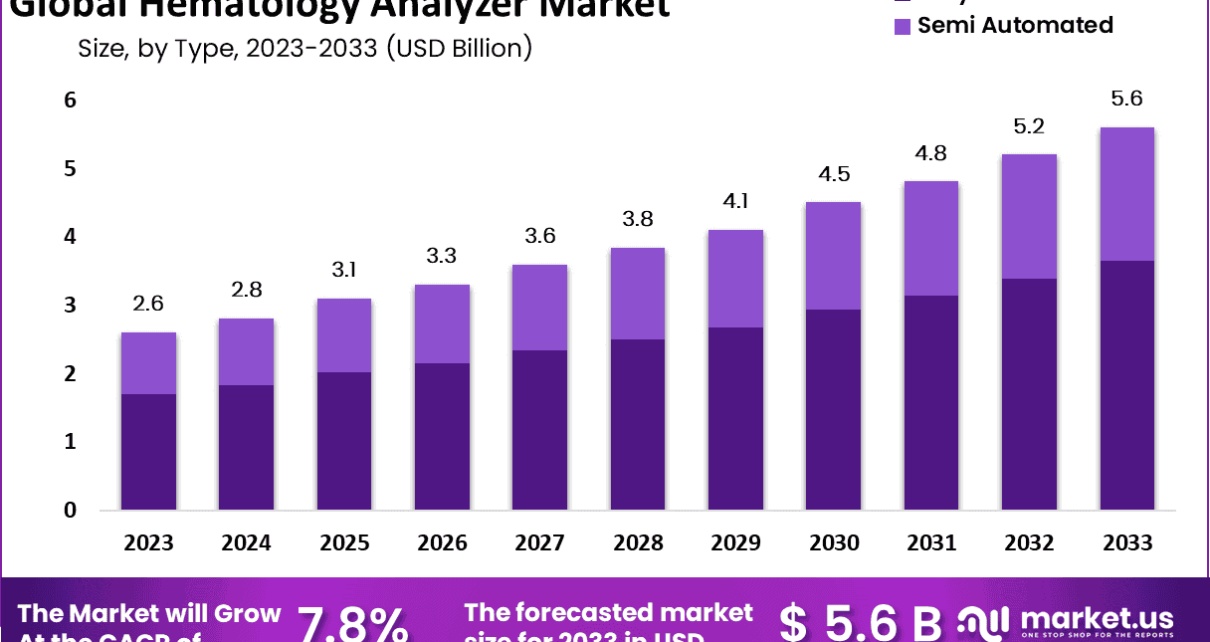New York, NY – June 24, 2025 – The global hematology analyzer market is expected to reach USD 5.6 billion by 2033, growing from USD 2.6 billion in 2023, at a CAGR of 7.8% from 2023 to 2032. This steady growth is mainly due to the rising demand for accurate and efficient blood testing. Hematology analyzers are widely used to detect and monitor diseases like infections, anemia, and immune disorders. With increasing global health awareness, there is a strong need for regular diagnostics, especially in managing chronic and non-communicable diseases.
Government investments in healthcare infrastructure are also boosting market demand. Many countries are focusing on improving public health services and expanding access to diagnostics. For example, India and Brazil are upgrading their rural and urban healthcare facilities. As part of this, hematology analyzers are being installed in diagnostic labs and hospitals to improve the quality of care. These investments are helping more people get timely and accurate blood tests.
The recent rise in infectious diseases has further highlighted the importance of hematology analyzers. During the COVID-19 pandemic, blood tests were critical for monitoring infections and patient health. The World Health Organization (WHO) promoted the use of lab diagnostics to track disease progression. This has made healthcare systems more aware of the need for reliable blood analysis tools, and many are now better equipped with hematology analyzers.
Another trend is the move toward automation and digital healthcare. Hospitals and labs are increasingly adopting automated hematology analyzers. These systems improve accuracy, reduce manual errors, and speed up testing processes. The U.S. Food and Drug Administration (FDA) supports the use of approved automated diagnostic devices, which boosts confidence in these technologies. As a result, more healthcare facilities are shifting to advanced, user-friendly systems.
Key Takeaways
- Strong Market Growth Forecast : An industry analyst noted the Hematology Analyzer market is projected to grow from USD 2.6 Billion in 2023 to USD 5.6 Billion by 2033.
- Rapid CAGR Projection : Experts predict the market will expand at a healthy compound annual growth rate (CAGR) of 7.8% throughout the 2023–2033 forecast period.
- Reagents & Consumables Leading the Way : In 2023, the reagent and consumables segment took the lead, capturing 41.6% of the total hematology analyzer market share.
- Fully-Automated Analyzers on Top : Fully-automated analyzers dominated the market with a 65.2% share in 2023, reflecting strong demand for efficiency and precision in diagnostics.
- Clinical Laboratories as Key End Users : Clinical laboratories emerged as the top end-users in 2023, accounting for 63.2% of the total market due to their diagnostic workload.
- North America Holding the Largest Share : North America led the global market in 2023, securing a 41.5% share and generating approximately USD 1.07 Billion in revenue.
Emerging Trends
1. Shift Toward Fully Automated Analyzers
More hospitals and labs are now choosing fully automated hematology analyzers. These advanced machines can handle large numbers of blood samples with minimal manual effort. They help save time and lower the chances of human errors. Automated systems also offer better consistency in results. As workloads in healthcare centers increase, automation helps staff focus on patient care. These analyzers can perform several types of blood tests quickly. This makes them useful for emergency and routine testing. Overall, the demand for fast and accurate results is pushing more facilities to invest in automation.
2. Integration with Digital Health Systems
Modern hematology analyzers are being linked to digital health records and hospital IT systems. This integration allows test results to be accessed by doctors in real-time. It also improves the tracking of patient history and supports faster diagnosis. When test results are shared electronically, it reduces the risk of lost or delayed reports. This makes healthcare more efficient and reliable. Digital connections also support remote monitoring and telemedicine. As digital health expands, analyzers that can connect easily with other systems are becoming more valuable in today’s medical settings.
3. Portable and Compact Devices
Portable hematology analyzers are gaining popularity. These compact machines are perfect for mobile clinics, emergency care, and rural health centers. They allow quick testing without the need for large lab setups. This is useful in areas with limited access to traditional medical labs. These devices are often battery-powered and easy to use. Healthcare workers can carry them to remote locations and get immediate results. Portable analyzers are helping improve access to basic blood testing. As more healthcare providers focus on outreach services, demand for small and mobile analyzers continues to grow.
4. Advanced Parameters for Deeper Analysis
Today’s hematology analyzers can do more than just basic blood counts. Many now offer advanced parameters like detailed white blood cell classification and reticulocyte counts. These features help doctors understand blood disorders more clearly. Diseases like leukemia, anemia, and infections can be detected early and treated better. Deeper analysis also improves disease monitoring and helps track treatment progress. With more detailed data, doctors can make faster and more accurate decisions. This makes advanced analyzers a preferred choice for hospitals and diagnostic labs handling complex cases.
5. Use of Artificial Intelligence (AI)
Artificial Intelligence is becoming a key feature in modern hematology analyzers. AI helps identify abnormal cells automatically, saving time for lab technicians. It reduces the need for manual review and increases the speed of diagnosis. AI-powered analyzers are also improving accuracy in blood test results. This means fewer errors and better patient outcomes. In some cases, AI can detect rare cell types that might be missed by the human eye. As the technology evolves, more analyzers will include smart features to support clinical decisions and reduce the workload in busy labs.
6. Sustainability and Eco-Friendly Designs
There’s a growing push toward environmentally friendly medical equipment. New hematology analyzers are being designed to use less energy and fewer chemicals. Some models now require smaller amounts of reagents, which reduces waste. Others are built with recyclable materials and low-power systems. These eco-friendly features are not just good for the planet—they also help labs save on operating costs. Hospitals and labs are increasingly choosing devices that meet green standards. As awareness of environmental impact grows, sustainability will play a bigger role in how healthcare technology is developed and adopted.
Use Cases
1. Diagnosis of Anemia
Hematology analyzers are often used to detect low red blood cell (RBC) counts. This helps doctors identify different types of anemia, such as iron-deficiency anemia or vitamin-deficiency anemia. These conditions are common in children, pregnant women, and older adults. Anemia can cause fatigue, weakness, and poor concentration. Early detection is important to start proper treatment. Hematology analyzers provide fast and accurate results, which supports better diagnosis. These devices are especially useful in clinics and hospitals where patient volume is high. By checking RBC levels, doctors can also monitor whether the anemia is improving after treatment.
2. Monitoring Cancer Patients
Cancer patients who are receiving chemotherapy often need regular blood tests. Hematology analyzers are used to monitor white blood cell (WBC) and platelet levels in these patients. Low WBC counts can increase the risk of infections, while low platelets can cause bleeding. Frequent monitoring helps doctors take quick action if levels drop too much. This can include changing the treatment dose or providing support like growth factors or transfusions. Hematology analyzers offer quick and precise results. This allows healthcare teams to protect patients from complications during cancer treatment.
3. Detecting Infections
Hematology analyzers play a key role in detecting infections. When a person has a fever or feels unwell, doctors often order a blood test. The analyzer measures the white blood cell count, which can show if the body is fighting a bacterial or viral infection. High or low WBC levels help guide the next steps in treatment. For example, a high count might suggest a bacterial infection that needs antibiotics. A low count might indicate a viral illness. These machines give fast and reliable data, helping doctors make decisions quickly and begin the right treatment early.
4. Routine Health Check-Ups
Complete Blood Count (CBC) tests are common during yearly health check-ups. Hematology analyzers make these tests fast and easy. The analyzer checks different parts of the blood, such as red cells, white cells, and platelets. This helps detect health issues even before symptoms appear. Early signs of diseases like infections, anemia, or immune problems can be found. The process is quick and doesn’t require much human effort. Results can be reviewed by doctors right away. This makes hematology analyzers useful tools in preventive care and maintaining overall health.
5. Pre-Surgical Screening
Before any surgery, it is important to check the patient’s blood. Hematology analyzers help doctors find problems like low hemoglobin, abnormal platelets, or bleeding risks. These checks are vital to avoid complications during surgery. For example, if blood clotting is poor, there’s a higher chance of bleeding. If red blood cell levels are low, the patient may need a transfusion. These analyzers give quick results, allowing doctors to prepare in advance. This improves safety and outcomes during surgical procedures. Hospitals rely on them to ensure every patient is ready for surgery.
Conclusion
In conclusion, the hematology analyzer market is growing steadily due to the rising need for fast, accurate, and efficient blood testing. These devices are now a key part of modern healthcare, helping in the early detection and monitoring of many diseases. With more hospitals adopting automation and digital tools, demand for advanced analyzers is increasing. Portable and eco-friendly designs are also making these machines more accessible and sustainable. Support from global health policies and investment in diagnostics are driving further growth. As healthcare systems focus on better patient outcomes, hematology analyzers will continue to play a vital role in improving diagnosis and treatment across the world.




